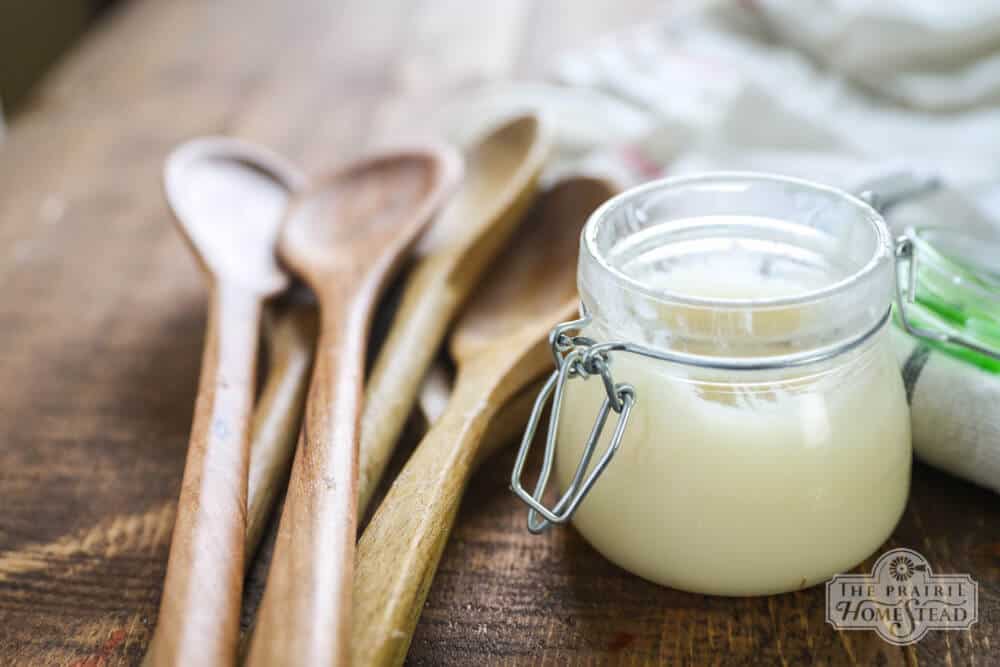
Teflon, silicone, and random plastic-y kitchen gadgets…
They do nothing for me… Nothin’.
Give me a good cast iron skillet and a wooden spoon and I’ll be one happy gal.
Lately, I’ve been hunting antique stores when I’m in need of new kitchen tools. Potato mashers with worn wooden handles, tarnished silver serving spoons, vintage carbon steel knives with lots of patina, and bowls with chippy edges bring a bit of extra warmth to my homestead kitchen. They seem to carry a special energy with them, and as I stir, and mix, and mash, I can’t help but wonder who gripped the handles before I did and what sort of families they fed.
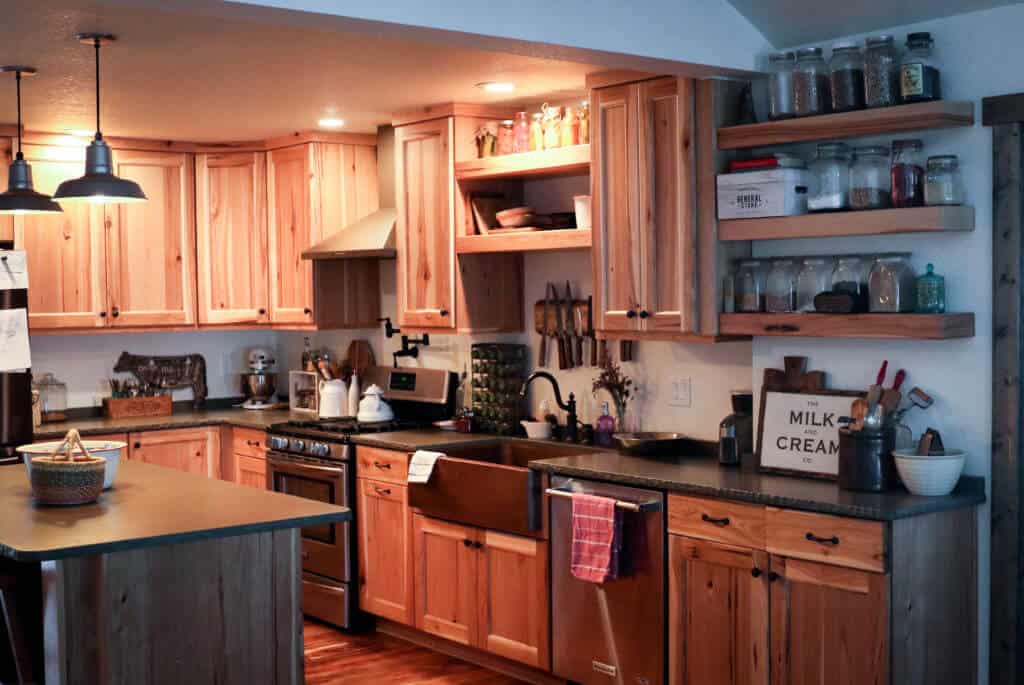
Back in my ultra-frugal newlywed days, I was all about the cheapest kitchen tools I could find. But not anymore. These days, I’d rather invest in high-quality tools that last, not Made in China non-stick pans that scratch and warp after a few uses and plastic spoons that snap under a load. I’m not a fan of our culture’s throwaway mentality so I’m happy to pay more for quality items that will last a lifetime. My kitchen holds my cherished wooden spoons from Old World Kitchen, a stack of wooden cutting boards I’ve grabbed on sale here and there, chipped enamel bowls from the antique stores, and my battle-worn cast iron skillets hanging proudly on the wall, just to name a few.
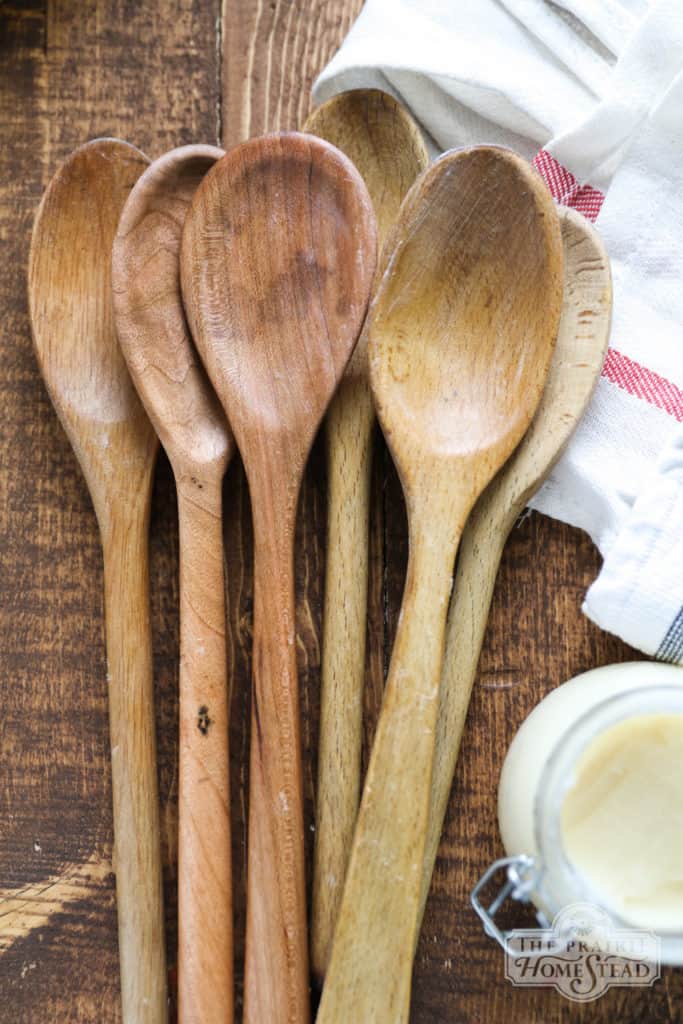
Tools like cast iron, stoneware, copper, and wood get better with age. Heritage-style tools generally require minimal care, and with just a bit of consideration, they can be enjoyed by generations and avoid the landfill like their cheap-o counterparts. And hey– here’s a fun fact: although I’ve used wooden cutting boards for years, I always assumed they were less safe than plastic boards. However, I recently stumbled across a research study at UC Davis confirming the exact opposite.
The study showed that plastic boards tend to hold onto bacteria more stubbornly than their wooden counterparts, especially once they become scarred with knife cuts. Safe to say, I feel incredibly validated in my wooden cutting board choice. Take that, plastic.
Anyway, wooden kitchen tools don’t require much TLC, but they do appreciate a bit of moisturizing every now and then in the form of oil or spoon butter.
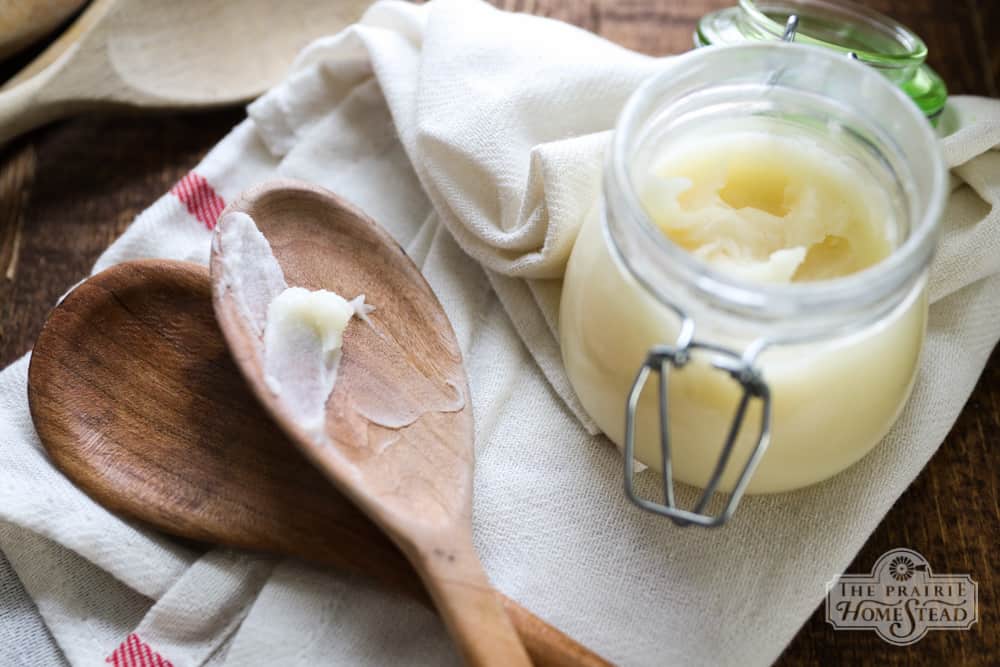
What is Spoon Butter?
Spoon or wood butter (also known as cutting board cream) is simply a mixture of oil and beeswax. It’s not something you eat, but rather use to moisturize and protect your wooden boards, spoons, and handles. (Have you noticed anything butter-related is always a good thing? There’s sweet cream butter, and whipped body butter, and now spoon butter… Hmmm…) Applying wood butter or cream to your kitchen untensils will prolong their lifespan and prevent cracking and splitting.
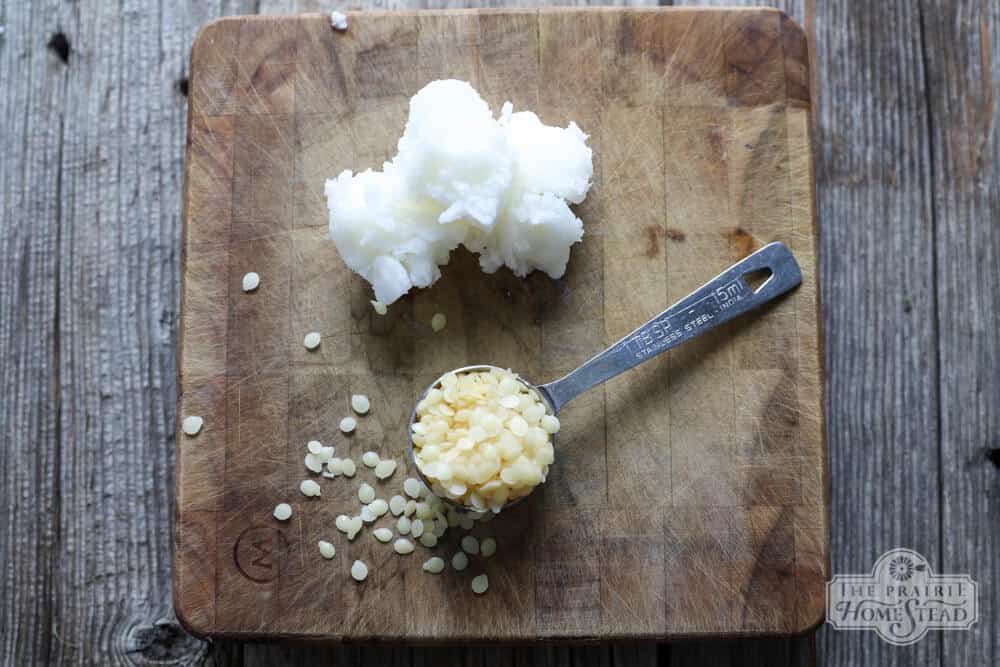
DIY Spoon Butter Ingredients
Many folks make their spoon butters and wood creams with mineral oil, but I’ve never been a fan of that stuff, so I opt for unrefined coconut oil instead. Walnut oil is another option, just be sure to skip things like olive oil or vegetable oil, since they have a tendency to go rancid. (And you really don’t want rancid spoons.)
I’m a fan of the little beeswax pellets or pastilles for many of my DIY recipes (they melt more quickly), but you can use chopped beeswax if that’s all you have. The measurements don’t have to be super-exact.
(Those are my affiliate links, by the way)
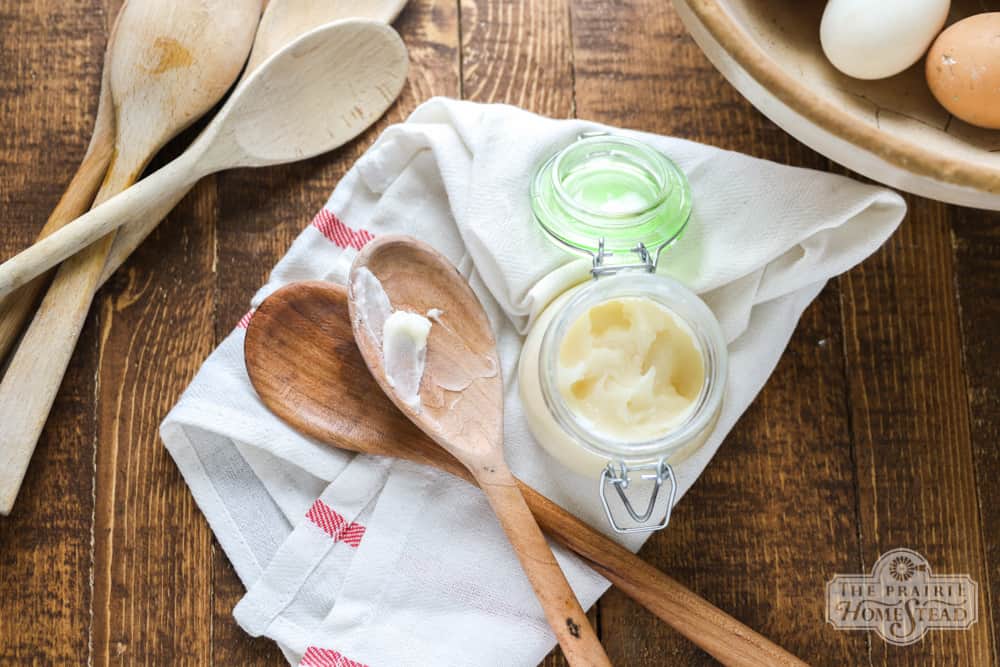
Homemade Spoon Butter Recipe
You Will Need:
- 2 tablespoons beeswax pellets
- 6 tablespoons unrefined coconut oil
Instructions:
Place the beeswax and coconut in a small glass jar and place the jar in a small saucepan filled 1/3 of the way with water.
Set on a burner over medium-low heat and stir occasionally until the beeswax is completely melted.

Let the mixture cool, then apply a generous layer to your wooden spoons, cutting boards, and any utensils with unpainted wooden handles. Rub the spoon butter into the wood and let it sit for several hours or overnight to give it a chance to soak in.

Repeat the process whenever your wooden spoons, utensils, or boards are looking dull and dry.
Your homemade spoon butter should keep for at least 4 months, if you don’t use it all before then!
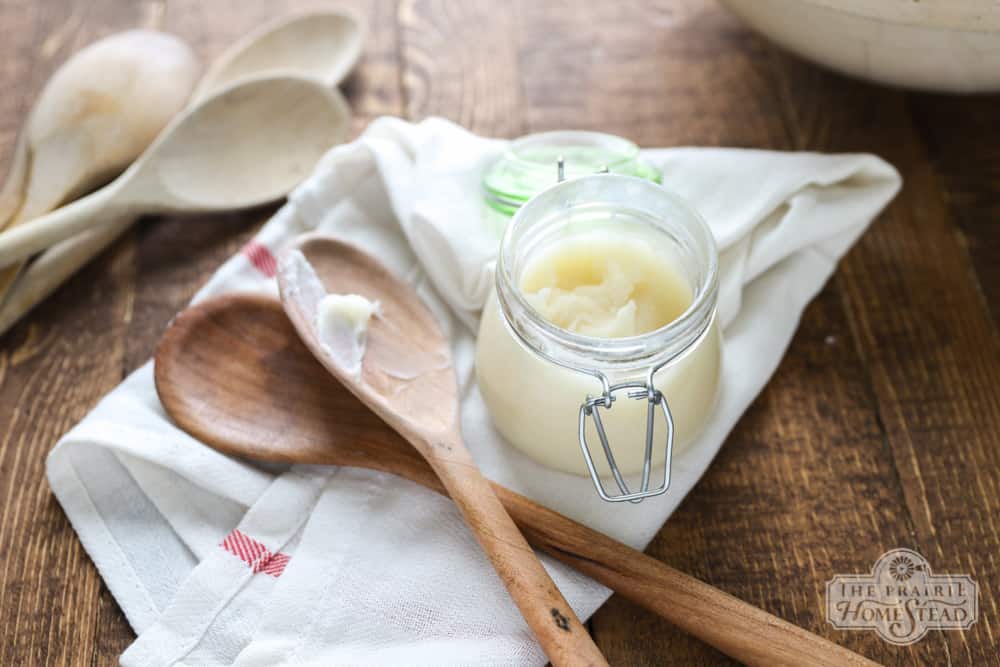
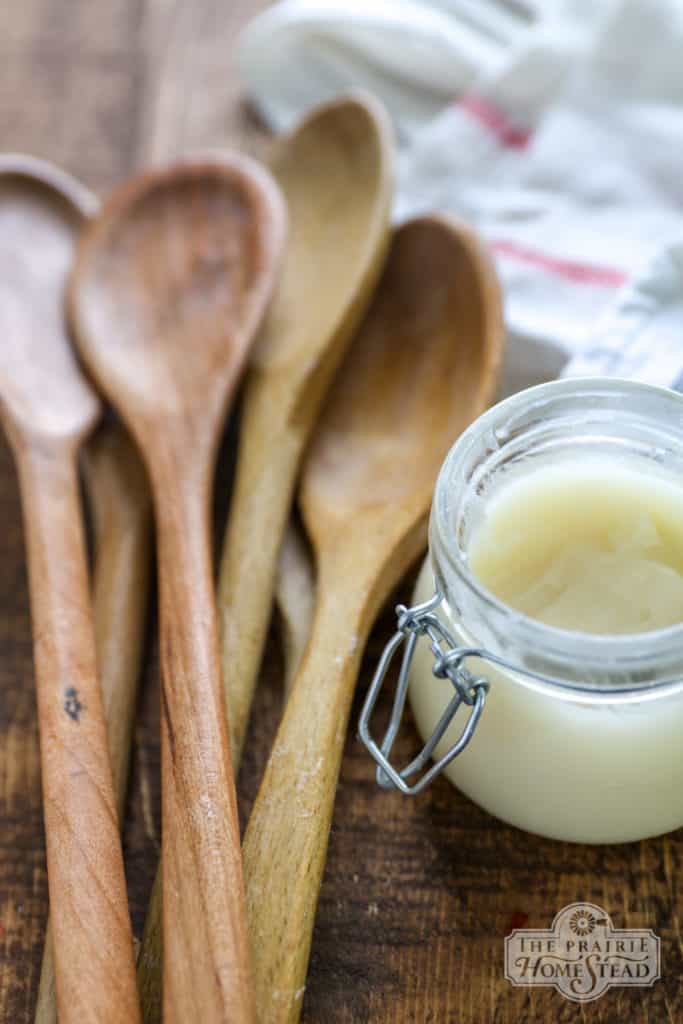

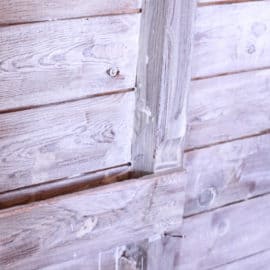

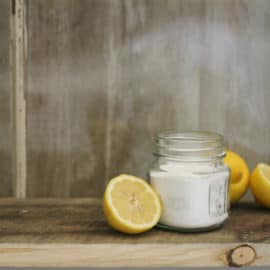

Thank you so much for this recipe! I have wooden utensils and cutting boards in need of treatment and didn’t want to use mineral oil.
BTW — your Old World Kitchen link isn’t right 🙂
Whoops! Thanks for the heads up!
Thank you for this post. I, too, love kitchen items that stand the test of time. My cast iron cookware is one of my most beloved possessions. My adult son took some pieces when he set up housekeeping and has continued to add to his collection.
Lodge is wonderful and everything cast iron should be. But give me an old, well seasoned piece of Griswold or other cast iron of the bygone era any day. There’s something sacred about continuing in my kitchen the cooking traditions that began in another generation.
I bought a wooden cutting board by Chicago Cutlery about 6 years ago. It was on sale because it had a fairly shallow split on the surface. But the cutting board size was right and I had to have something affordable STAT, so my minimum requirements were met. Still, I was concerned about that split harboring bacteria. It couldn’t be buffed out without damaging the board because of the size of the split.
Someone wrote a blog post around that time about using coconut oil to season wooden kitchen tools. They extolled the virtues of coconut oil’s antibacterial, antimicrobial benefits and made the point that wooden kitchenware can be easily sanitized with coconut oil!
After all these years the board has a beautiful weathered-but-cared-for look. I only use the wooden one for meats and have a corian marble one for veggies.
Thanks for evoking happy memories of great meals lovingly prepared on reliable kitchen ware. Food just tastes better that way!
I agree– Lodge is great, but the antique skillets are so special! And the weathered-but-cared-for-look is my fav. 🙂
Lodge started pre 1900. so it’s antique as well. Like with wagner and gris, you have to look for it. Too many think its a newcomer, lol. Its the only pre1900 foundry still in operation with the same name. 🙂
Lodge also brings in a lot of items imported from China under their name. More Wall Street antics. Nothing I would ever trust to cook food in. I know they do still make some of their line here, but not everything, you need to be careful about any of the newer stuff.
I made this last week and absolutely love it! Makes my butcher block work table look like new! I’ve been using it as a chapstick too, because hey, it’s all natural! (Also so nice to see you at HOA in Front Royal this past october. Looking forward to next years conference!)
Hi there. Loved the post and recipe. The pictures show quite a bit of butter on the utensils; do you rub it all in after the set time? Rinse? Would this work for conditioning iron skillets? I currently just rub coconut oil into the pans and heat a bit if the pan isn’t hot enough.
Yes, just rub it in and let sit overnight. The pics are more of an “in-progress” look, you wouldn’t need that much butter on the spoons overnight. 🙂
I’m not sure you’d need the beeswax with cast iron– I’d just use coconut oil, etc, and bake it in.
Wow!! I never even thought about something like this. I will be whipping up some of this stat! I love my wooden spoons (don’t get me started talking about my love for cast iron. . it makes my husband jealous! ;)) but hate how they get so worn and sad looking after awhile. Now, I know just what they need: a little tlc and spoon butter. Thank you!
You will have happy spoons! 🙂
I just made the spoon butter and it works beautifully. It should be fine on cast iron pans too as I have seen something similar sold for just that. I think a jar of spoon butter and a nice wooden spoon would make a nice gift. Might start on Christmas 2020 early!
Sounds like a great idea! And spoon butter would make a GREAT gift!!
I don’t think beeswax would be a good idea on the cast iron, as a wax it will always re-melt with heat. Coconut oil also isn’t the best oil to use for cast iron. The best oils to season cast iron with are known as drying oils like Flax or Walnut oil. Both are used as a wood finish as they will polymerize and form a dry film just from exposure to air & light. Add the heat and you have the best seasoning oil possible for cast iron.
You can also use either of those oils alone or with the wax for your spoons. Far better than coconut oil.
NOW I have a water in my mouth loved this recipe this looks so tasty I will definitely try this one next week in my weekend holiday.Love this one Thanks for sharing hope to see more from you.
I would think a butcher block counter top will benefit from an application wood butter.
My husband and I have a few beehives. Could I use the fresh beeswax from our hives instead of the pellets?
Brenda!
After filtering your beeswax it would be perfect for this project. You can’t get any better than home-grown beeswax.
i tried my own spoon butter and looks really great recipe, thanks for your effort and very thanks for your share ?
I’ve loved wooden utensils all my adult life and inherited several bowls and boards. I knew they needed SOMETHING but didn’t know what. Thanks
Enjoy! I’m sure your collection will look beautiful after a little conditioning! 🙂
What a great way to preserve the wood for your kitchen utensils! Thank you so much for sharing!
So nice to hear someone else echo my sentiments!! Love everything about your article including the recipe!
Thanks Anita! <3
LOVE LOVE LOVE cast iron, good ole stainless steel and cooking stones! Wooden instruments my favorite and ooooh golly to copper and patena colored copper! I have tons and will NEVER give them up! Country chick to the core! Thanks Jill!
Beneita
Yes indeed! The more patina and age, the better. 🙂
Thank you! I’ve been wondering how to clean up my wooden cutting board. I’ve also been using plastic boards, thinking wood is less sanitary. I’m glad to know differently.
Wonder how this would work on wooden countertops, my kitchen counters are reclaimed wood…..any feedback or ideas?
I imagine it’d work well for that!
I use this on my butcher block counter top once a month and it works great. I also use on all my antique wood furniture. I have been making this “wood butter” for years, but always knew it as “wood wax”. I do add lemon essential oil to mine, but that is just a personal preference. The lemon does not affect the taste of food at all.
Hi, I was wondering if you could use this on furniture and if so, could you then scent it with essential oils?
Many thanks ?
I’m not sure– I think it might work, although it would depend on the piece, the type of wood, and the finish.
Could you add lemon essential oil in a small amount, or would that be unnecessary and potentially flavor the food you cook?
I was pondering the same thing– I think you could! Although there is a chance it would slightly flavor foods
Yes, you can add the lemon essential oil and it will not affect the taste of your cooking. I have always added the lemon essential oil because I also use it on my antique wood furniture as a “wood polish/wax”.
Can you use this on furniture?
Hmmm… possibly? I haven’t tried it, though.
I rubbed spoon butter into my 90 year old oak dining room table- it works beautifully, the wood still feels and looks healthy and hydrated even several months later. I had used Howard Feed-N-Wax Wood Polisher and Conditioner for years, but was always disappointed how quickly my table top went back to looking thirsty and dull. So glad to have found such an easy and better solution. I also tried the spoon butter on our leather furniture that had gotten dried out looking- it works nicely, but use it sparingly and buff it out so its all absorbed.
I hand carve spoons from wood I cut on my farm. I made your spoon butter recipe. It works great. After I do the final sanding I apply the butter. It’s one of the parts I like best after all of the work of carving I get to see the finale product. The grain and color of the wood and all of the particulars of that one spoon. There will never be another one exactly like it.
The thought of someone using my spoons long after I’m gone makes me smile.
We’re so glad you like the spoon butter recipe! And how cool that you hand carve your own wooden spoons! Do you sell them, or just make them for family/friends and so on?
Yes, I use on all my antique wood furniture, but I add lemon essential oil to my recipe that I have been making for years. You really don’t have to use the essential oil, I just do because I love the smell of it.
Dose it have to be unrefined coconut oil?
You should be OK with refined or unrefined
could you possibly put a weight amount as well for the bees wax? I have a big block I’m trying to use up before I switch to the Pellets.
I used a shredder to make it into a usable size.
Marie, did you ever get a weight for the bees wax – I only have blocks of it too.
2 TBS bees wax pastilles = 18 grams
An old saying regarding applying oil to your wood goes like this… Once a day for a week, once a week for a month, once a month for a year, once a year for life. There is life in that wooden spoon or board that plastic cannot give…and it show in your cooking.
Love this Nancy!
I was wondering if this would help to prevent staining on a cutting board, eg. when you slice purple cabbage?
It should prevent staining. The oil & wax condition & seal the cutting board.
I agree with your sentiments towards antique kitchen ware. I have a couple of old aluminum measuring spoon sets that I use all the time. My husband was given a set of cast iron pans & we LOVE them. I’d read somewhere that adding a citrus essential oil to a kitchen utensil butter works just fine, I think it was just a few drops per batch. I always love reading your blog, thank you for another great post!
Love my wooden spoons! Thanks to my essential oil friends for finding your site 🙂
Some are talking about their cast iron skillets, is this butter what you use on them? Or just straight coconut oil?
Good to know. I have recently been collecting iron skillets and wooden spoons. Thanks for the recipe. Trying to get the plastic garbage out of my house. Love you blog. Have a great day.
Love having this! I came over here to search it because I downloaded your Heritage Kitchen Handbook and the recipe in there left out step #3. I assumed I had it figured out but wanted to make sure I wasn’t missing something else
I think the link you meant for the spoons is this? https://www.poldersoldworldmarket.com/collections/dreamware
But wow, the prices…
Thanks for the recipe…will have to try it…
Loved the Spoon Butter recipe. Thanks. I love old crocks, cast iron and wooden spoons. I have a local man that is called The Spoon Man who makes beautiful spoons. I will have to tell him about that. He may already know. I have a question. After the spoons have soaked in the butter I guess you wash them like always. Can the butter be kept out or put in fridge?
Why not just rub coconut oil into the spoon or board?
What do you use do make your cast iron so eggs, or really anything, will not stick?
Thanks, this worked well for my utensils and cutting board. But…
If your stuff hasn’t been treated in a long time and/or gets heavy use I highly recommend sanding everything before you begin. Utensils tend to get roughed up on the side from tapping them against the edge of a pot to remove food particles, and cutting boards can get nicks. Start with a rough sandpaper like 50 to take down the rough stuff, then go to 150 to even out the surface. Finish with 220 for a super smooth finish. Be gentle when starting out so you don’t take off too much; this is especially important for softer woods. Once the sanding is done, wipe off the wood dust with a damp cloth then thoroughly wash and dry everything before applying the spoon butter. I hope this is helpful!
Your recipe calls for volume measurements. Can you tell me if that holds true for the same 1:3 ratio by weight?
1 Tablespoon of coconut oil is 13.6 grams
1Tablespoon of beeswas pestilles is 9 grams
Recipe is 2 TBS beeswax and 6 TBS coconut oil
So that would be 18 grams of beeswax and 81.6 grams of Coconut oil
Thank you for sharing this recipe!!!
Do you use this for rolling pins?
Also, is there anytime a wooden utensil should be cleaned via dishwasher?
I could not agree more with this article. Like you when my husband and I married I was all about buying cheap because we were on such a tight budget. It didn’t take me long to learn when it comes to things you use everyday in your kitchen it was worth spending the extra money for good quality and cutting back elsewhere. I am always on the hunt for old kitchen odds and ends. You just can’t beat the quality! I have pieces of cast iron that are over 100 years old. Thank you for sharing your spoon butter recipe. I have been using it for sometime now and my wooden utilities look amazing!
Can you recommend another oil to use? Allergic to coconut & can’t have other nuts either… I use lamb tallow on my cast iron, but am not confident it imparts any antibacterial qualities useful for wood.
Flaxseed oil works well.
Questions Hey Jill! I love this idea and really enjoy your podcast! Can you tell me where you get those jars? My husband & I are making wooden spoons for family gifts for Christmas and would like to include the “Spoon Butter.” I have lots of mason jars but love the jars you show!
Thanks!
I’m allergic to the propolis in beeswax. Do you know of a substitute that will be compatible to use on wood and not go rancid?
Soy wax.
Paraffin wax.
Rice bran wax.
Sunflower wax.
Can all be substituted for bees wax. Keep in mind that each of these will melt easier than bees wax and with the soy, rice and sunflower wax, you might want to up it to 2.5 TBS to get the desired consistency.
Hi there!
I made this spoon butter recipe, and let me tell you, it is AMAZING! Thank you so much for this!! It’s exactly what my wooden utensils and cutting boards were aching for.
Question for you though – in the instructions it says to let the spoon butter sit for several hours or overnight. But then it doesn’t say whether you’re supposed to wipe off or wash off excess after that. Are you supposed to wash it after it soaks in? Wipe off the excess? Buff it out? Or just leave it and let all the spoon butter goodness stay? It doesn’t say what you do after letting it soak in.
Thanks again for this recipe!
What are the size of the jars that you are using?Also can you increase the recipe like double, Or triple, to make a larger amount at one time?
Can you use just coconut oil?
Yes, or genuine traditional method, mineral oil.
Love the Prairie Homestead!!!
I see other people say they use this on wood furniture. Would this work on a wood floor. Our farmhouse is almost 100 years old. The oak floor has had the “finish” literally walked off of it. Do you suppose it could be sanded and this spoon butter put on it to make it look better? Or do you think i would just end up mopping it off?
Yes, it will be walked off, and in short order. Short term, it’ll keep dirt/water off freshly sanded spots.
If you’re going through the trouble of sanding, get a container of stain to match it, then finish with something compatible for sealant such as polyurethane.
Three things:
1. Can the spoon butter recipe be used on solid wood furniture, or do you have another recipe for furniture items?
2. Be careful about the enamel on enameled cast iron pots. All but Le Creuset are enameled in China, even Lodge enameled pots are made in China. In France, they continue to use old-world methods for enameling and there is no lead used. In China, they use lead in the enameling process. I don’t know about you, but I would rather pay $300 for a Dutch oven that does not contain lead, than a $35 pot that contains lead.
3. I am REALLY enjoying all of your videos and your website. I’m relatively new to homesteading and I find your information easy to follow, unlike many other sites that are often unrealistic or confusing.
Hello,
Someone asked but there was no answer. Can I use this spoon butter on my wooden rolling pin? I just got a new one and it is not sealed, and is kind of rough to the touch. I’d like to use this butter but not have it interfere with pastry, etc. Do you think I can use it?
Regards,
Darlene
Yes, you can. But if using the rolling pin on pie crust, the shortening in the pie crust will do the same thing.
Love this spoon butter! Thank you
Could you use this on leather boots for conditioning?
Why cant I just microwave this instead of boiling? ive done this for over a year to use in my hair as a pomade. I melt the wax in 30 second increments then stir in castor oil and heat 3 or four more times, 30 sec at a time, vigorously stir and i’m done! its great in your hair and I was making spoon butter and did’nt know it. so why cant i do this instead of boiling for my wood working projects?
It’s just about melting the ingredients together, and it’s a more gentle process when you use a double-boiler. But if you have a microwave option that works for you, feel free to try it!
Several people asked, but I could not find their reply. Once the spoon butter is made, does it need to be refrigerated or do you leave it in the cupboard?
Leave it in a dark and cool place and it will be fine. No refrigeration needed.